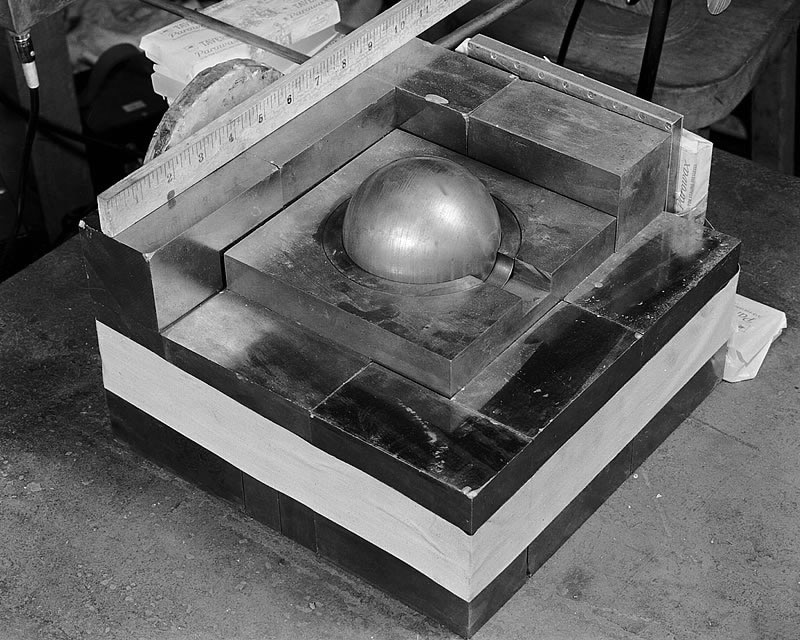The Demon Core had the potential to be one of the most dangerous devices of the 20th century. To understand it, however, we first need to understand how it narrowly escaped its own nuclear detonation. It was the end of World War II. Victory in Europe Day was behind the U.S. and victory in Japan was in sight. The U.S. had a plan to force a surrender from the Japanese government. On August 6th, 1945 the United States dropped the first atomic bomb, codename Little Boy, on the Japanese city of Hiroshima. Just 3 days later the U.S. dropped a second a-bomb, codename Fat Man, on the city of Nagasaki. At this, the Japanese forces surrendered and World War II was brought to a swift end.
The U.S. forces did not expect this outcome. Officials expected to need to use three nuclear weapons to force the surrender of their last standing rival in the great war. This weapon, codename Rufus, was on standby when Japan announced their surrender. The bomb would never cause casualties in war time, it would however lead to a handful of deaths in peacetime. This is the story of the famed Demon Core.
Tickling the Tail of the Sleeping Dragon
The original use for the third atomic bomb was suddenly no longer applicable. Scientist saw this as an opportunity to do dangerous nuclear tests to understand the processes of the device at a deeper level. Almost immediately after Japan’s surrender, scientists at Los Alamos Laboratory began to disassemble the bomb nicknamed Rufus. The most notable studies happened on the core of the bomb. These fatal tests would earn the core the name The Demon Core.

The Demon Core was a subcritical mass of Plutonium weighing in a 14 pounds and measuring just 3.5 inches in diameter. Without getting to deep into the details, this was a very dangerous medicine ball. Scientist would often perform tests with this strange device that bordered on insanity. It did not take long for these tests to be nicked-named, “Tickling the Tail of the Sleeping Dragon.” These tests would eventually claim the lives of a handful of Los Alamos scientists and cause life long suffering for others.
The First Incident
Days after the testing on the Demon Core began Harry Daghlian performed a test on the sphere that would prove fatal. At the end of a long day of rigorous study Daghlian returned to the lab to try some new tests. He sat alone in the lab at Los Alamos on August 21st, 1945. Harry was stacking Tungsten bricks around the Demon Core to test its reaction to the material. Each brick slowly pushed the limits of the core. Finally, the Demon Core went subcritical. He quickly noticed the dangers of the situation and knocked over the stack of Tungsten bricks ending the reaction. The subcritical event lasted just seconds but it was long enough to deliver a fatal dose of radiation. Harry Daghlian died of radiation poisoning 25 days later.
In response to the incident involving Harry Daghlian the lab adopted more stringent safety measures that would protect their researchers for quite some time. The peace afforded by the new safety procedures would not last forever. Louis Slotin became all too comfortable with the Demon Core. He performed tests with a bravado and seemed to enjoy showing off his lack of fear around such a dangerous device. A colleague went as far as to say he will be, “dead within in a year” while discussing Slotin’s tests.
The Second Incident
Nearly one year after the accident that took the life of Daghlian, Slotin began a test that he had performed many times in the past. This test has often been criticized for its utter lack of safety precaution. Slotin’s experiment required him to lower two halves of a beryllium sphere (a neutron reflector that would cause the core to go supercritical) around the Demon Core. The most important part of this experiment was to keep the pieces of the beryllium sphere from touching. If the sphere completely enclosed the core then a subcritical event was inevitable. To maintain a small gap between the halves of the sphere Slotin used a flathead screw driver to create the gap. Yes, this is as dangerous as it sounds.
On May 21st, 1946 Slotin’s screwdriver slipped. The Beryllium casing completely enclosed the Demon Core causing it to go supercritical. Louis knew the dangers of the situation and quickly threw the top halve of the sphere off the core ending the event. It was a valiant effort, but it was too late. In a matter of seconds everyone in the room was exposed to life threatening levels of radiation. Slotin himself took in 1,000 rad (200 rad can lead to serious illness or death). He would die 9 days later. Of the 7 others in the room 6 would die of cancers or other radiation related causes. After this event the Los Alamos Lab cancelled the plans to use the core in nuclear testing and was eventually melted down to be used in other cores.
Conclusion
The Demon Core was an incredibly small, yet incredibly dangerous ball of material. A lackadaisical attitude towards to the core lead to the death of 7 people and could have lead to much more. The events surrounding the Demon Core and the ramifications are far reaching. To learn more, watch or listen to this week’s episode of Things I Learned Last Night!
Sources
The Chilling Story of the Demon Core and the Scientists Who Became it’s Victims
Tell us what you think of this content!

